The original game did not allow playing in a way that could be seen as realistic, as several crucial aspects were simply missing from gameplay. This led to a comparably simple gameplay where the player could for example choose the train engines simply by their top speed. Both TTDPatch and OpenTTD have since added several features that enhance gameplay and allow playing the game as a kind of virtual model railway instead of simply making money by rushing coal from one end of the map to the other one using insanely fast MagLev trains (although this can be fun just as well).
This page is therefore dedicated to playing the game in a "realistic" way.
What is realism?
The game cannot be realistic (without quotation marks), since it is a game after all. As a game it has to simplify reality to yield a playable result. Some things just cannot be recreated in the game, because of scale issues, because of hardware limitations or simply because the feature is not implemented in the game.
That being said it should be clear that 100 per cent "realism" cannot be achieved in the game. However, the goal is playing in a way that takes real railways as inspiration. That simply means one takes a look at how real railways are operated and tries to simulate this within the limits of the game. Of course, the degree of realism is a matter of taste and varies for every player. Some like to create ultra complex intersections and optimized time tables, other player focus on beautful scenery and landscape, and then there are those who simply do not care about anything but the income display at the end of each game year. And everyone is right about playing the game his/her own style.
 Example: In Japan there are several dedicated high speed tracks for Shinkansen
trains. These trains are known to be the first high speed trains in the world,
travelling at 200 kph or more since the early 1960s.
Example: In Japan there are several dedicated high speed tracks for Shinkansen
trains. These trains are known to be the first high speed trains in the world,
travelling at 200 kph or more since the early 1960s.
One can see from the various possibly style of gameplay that there is no "right" or "wrong" way to play the game. Everything that is described here is only one possible way, one can play in a completely different style and still have lots of fun.
Game settings
There are a bunch of settings that influence gameplay and should be set when playing realistically.
- Realistic acceleration
The physics model in the original game was extremely simple and hence completely unusable for realistic gameplay. A lot of effort has been put into improving this model, and as a result the player is required to think a bit more about how to lay tracks or which engines to buy. It also differentiates more between the strong and slow freight engines and the faster express engines. - Weight multiplier for freight trains
Real freight trains are much longer and heavier compared to the short trains for passenger service. However, this cannot be simulated in the game, since every "freight" (including passengers) have a predefined weight, and the lenght of trains is somewhat limited. To work around this problem, a weight multiplier has been introduced for everything but passengers. This makes freight trains much heavier, which combined with realistic acceleration has a great influence on gameplay, especially in hilly terrain when a heavy freight train has to crawl up a long sloped track. - Vehicle sets
The original vehicles were neither balanced nor (from todays perspective) graphically pleasing. By now countless vehicle sets have been released, most of them based on real railways from all over the world. The choice is up to the player, depending on the scenario and personal preference. In addition to vehicle sets there are also sets that include new industries and freight types, thus enriching gameplay even more.
A final remark: Using monorail or MagLevs is unrealistic by definition.
Know the real world
Basically, the main principles of real world railway construction also apply to the game. That means one tries:
- to build as inexpensive as possible
- not to level the mountains
- to build only those tracks that are really needed
- upgrades tracks and stations only when increased traffic requires enhancements
- uses overhead wires only where it is useful
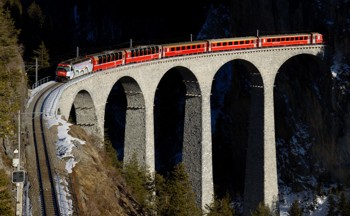 Example: In Switzerland with its difficult topography a number of great
engineering feats had to be achieved in order to cross the Alps. The famous
Landwasserviadukt is only one of many examples. (photo: David Gubler, bahnbilder.ch)
Example: In Switzerland with its difficult topography a number of great
engineering feats had to be achieved in order to cross the Alps. The famous
Landwasserviadukt is only one of many examples. (photo: David Gubler, bahnbilder.ch)
Of course there are also railway lines that have been built without any consideration of the terrain. However, one always needs to consider why such lines have been built, and more often than not political or military reasons were the main driving force for railway building. In addition, the traffic structure has been changing drastically since the beginnings of the railway age, causing some lines to become much more important than originally planned, while others were closed as they were not needed anymore.
In short one should try to adhere to the principles outlined above, but if one does not it will work just as well...
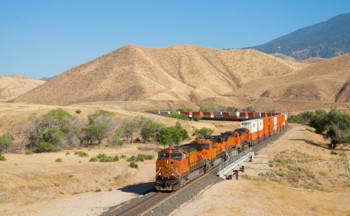 Example: In North America, but also in Australia and other large countries one
will find extremely long freight trains being pulled by several engines, with
additional helper engines at the back of the train. These tracks are typically
not electrified due to the geographic and climatic difficulties for maintenance
(just think about what a tornado would do to overhead wires).
Example: In North America, but also in Australia and other large countries one
will find extremely long freight trains being pulled by several engines, with
additional helper engines at the back of the train. These tracks are typically
not electrified due to the geographic and climatic difficulties for maintenance
(just think about what a tornado would do to overhead wires).
(photo:
David Gubler, bahnbilder.ch)
The rules above are of course very generic, they have to be adapted to the actual scenario: In North America one uses heavy freight trains, in Europe the rail network is much denser and most lines are electrified. So if you want to play a game in a realistic way you will also need to get at least a basic knowledge about relevant railway history and local peculiarities of the railway system.
Realistic rails
So how does one build realistically? One first step is to take a look at how real railways are laid out. The following table lists some examples of German railway lines. It shows how slope steepness, curvature radius and maximum speed relate to each other. Of course other factors also influence speed, such as the signalling infrastructure.
| Line | Year | Traffic | Speed | Slope | Radius |
|---|---|---|---|---|---|
| Geislinger Steige | 1850 | express, passenger, freight | 70 kph | 22.5‰ | 278m |
| Schwarzwaldbahn | 1873 | passenger, freight | 70 kph | < 20‰ | 300m |
| Frankenwaldrampen | 1885 | express, passenger, freight | 70 kph | 29‰ | 300m |
| Höllentalbahn | 1887 | passenger | 100 kph | 57.1‰ | 200m |
| SFS Hannover-Würzburg | 1991 | express, freight | 280 kph | 12.5‰ | 5100m |
| SFS Köln-Rhein/Main | 2002 | express | 300 kph | 40‰ | 3320m |
So how do these factors correlate? In order to achieve a high top speed, the slopes should be as flat as possible, and the curves should have the largest possible radius. For modern high speed tracks, slope steepness may be higher, since modern trains have much more power.
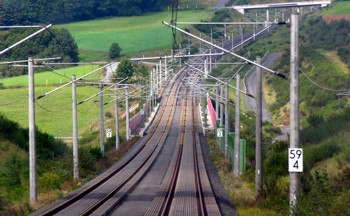 Example: The high speed track from Cologne towards Frankfurt is built with
extrem slopes, so it can be used exclusively by the ICE 3 high speed train
units.
Example: The high speed track from Cologne towards Frankfurt is built with
extrem slopes, so it can be used exclusively by the ICE 3 high speed train
units.
(photo: Hansueli Krapf)
So what needs to be thought of when laying the tracks? The following paragraphs give some general rules that one can follow. Of course, various compromises will have to be made, for lack of money or missing space. Most of the time, there is not the one optimal solution.
The basic idea is to always keep in mind that there might be expansions in future. That means to leave room for additional tracks or longer station platforms. This also means to perhaps build with larger curves and flatter slopes than actually required. They might be more expensive, but a later reworking might be even more difficult when there are lots of heavy trains running on the tracks.
Curves
- Avoid curves if possible
A railway line should have as little curves as possible between start and end. The shortest connection between two points is straight - simple as that. And the shorter the line, the more income will be generated by your trains, simply because it reduces the travel times. - Use large curve radiuses
If you cannot avoid curves, they should have as little impact on train speed as possible. This means the distance between direction changes needs to be as large as possible.
In the early years smaller curves are acceptable, since trains can only reach comparably low top speeds. For dedicated high speed tracks in later game years the required room for large curves needs to be taken into account.
Slopes
- Avoid slopes if possible
Slopes in the game are much steeper than those of real railways, so they should be avoided at almost any cost. So if start and end of a line are on the same height level, one should avoid height changes in between. Typically it is much more useful to build around a mountain, than having trains to climb across. - Keep slopes as flat as possible
There are of course many cases where height differences are not avoidable. In such situations one should always have a number of flat tiles between two slopes. This might not always be easy, it might cost lots of money and be difficult to build, but if a train later on cannot climb the slope a bigger investment is well worth the investment.
As with the real railways, later tracks may have steeper slopes, since stronger engines should be available then.
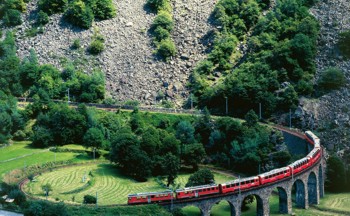 Example: The circular viaduct in Brusio allows the Bernina line to tackle huge
height differences within little space. Still, the line belongs to the steeps
adhesion lines in the world.
Example: The circular viaduct in Brusio allows the Bernina line to tackle huge
height differences within little space. Still, the line belongs to the steeps
adhesion lines in the world.
(photo: Wikimedia-User Plattens)
Bridges and tunnels
- Do not build bridges or tunnels as an alibi
This basically dismisses all bridges and tunnels that have a length of two fields, i.e. the bridge heads or tunnel portals are directly adjacent. Such a bridge does not span over any gap, and two tunnel portals next to each other are quite useless as well.
A notable exception are the Enhanced Tunnels in TTDPatch , which in fact are very useful. - Do not build overly long bridges / tunnels
A base tunnel cutting through the whole mountain range might be cool, but it also is extremely expensive, and, above anything else, you cannot put any signals inside. In order to allow as many trains as possible to use long tunnels, one would need several tunnels in parallel, which is even more expensive and more unrealistic. The same problems apply to long bridges. If in doubt, try to build the tracks around a mountain or deep valley, if you can manage that with a few turns and slopes.
For modern high speed tracks more money will be available to build longer tunnels, since the faster trains should not be slowed down by curves and mountain slopes.
Electrification
- Build electric tracks only where it is needed
Building overhead wires costs quite a bit of money, and for real railways the costs for power stations and the like have to be added to the equation as well. Finally one also needs new engines for the trains. This in turn simply means that not every line needs to be electrified, especially those serving remote locations with only a little traffic. Typically, electrification was introduced on lines with much traffic in difficult suurroundings, like important freight lines or in mountaineous terrain.
Since you cannot change engines in the game (trains always have the same engine for the whole line), you will also have to take care to build overhead wires in such a way that the whole line can be changed to electric engines. - Do not build separate networks
In some ways the electric railway network is kind of a rebuilt of the existing network. The original expansion of the network was done by expanding lines branching out from the existing network. With electrification it is the same thing, except that one only needs to build overhead wires instead of a completely new track. Still you always try to branch out from existing electric lines, since you can switch as much traffic as possible to electric traction with as little effort as possible. So if you have built overhead wires in an important station in your network because one line leading there was electrified, the next step would be to upgrade other lines to that station as well. In a similar way one should always try to expand electrification on lines that have already been electrified partly because of another line that uses the same tracks for a certain distance - in such cases you can greatly benefit from electrification with little extra effort.
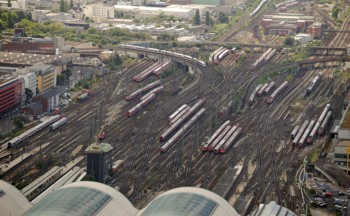 Example: The tracks in front of Frankfurt main station with their countless
switches and connections into several directions show how real railway
intersections look like (note the ramps leading towards the left and right).
Example: The tracks in front of Frankfurt main station with their countless
switches and connections into several directions show how real railway
intersections look like (note the ramps leading towards the left and right).
(Foto: Eva Kröcher)
Junctions / multi-track layouts
- Build only what is actually needed
Many players tend towards building complex junctions and crossings which allow going from any direction to any other direction. This is complete overkill and highly unrealistic. Real railways mainly use Y-junctions, where one line splits into two lines, typically near a station. The smaller cases consist just of a number of switches (which can be simulated using path signals), more complex arrangements use short bridges or tunnels to avoid track crossings.
Building only those tracks that are actually needed will also minimize the danger of trains getting lost and causing chaos on the network. - Build double tracked
Compared to single tracks, double tracked lines have much more capacity, simply because there is a dedicated track for each direction. This is also the common layout of real railway lines. In special cases with very dense traffic or huge differences in top speed it might be useful to add another track or two, in order to split trains in such a way that slow freight trains do not block faster passenger trains.
On the other hand there are smaller lines with only little traffic which do not need to be double tracked completely. Having a number of passing places, for example in stations with two platforms, is enough for such lines.
Eye candy
Wenn man sich schon die Mühe macht, vorbildgerecht zu bauen, soll das Ergebnis auch gut aussehen. Dies ist mit den Grafiken aus dem Original nicht unbedingt möglich, aber man kann ja viele neue Grafiksets ins Spiel einbinden.
Bahnhöfe
Es gibt im grfcrawler einige Sets mit Bahnhofsgrafiken, insbesondere auch für Güterbahnhöfe, die dann beispielsweise Kohlebunker, Getreidesilos oder Rohrleitungen für Öl darstellen. Diese Möglichkeiten sollte man allein schon des besseren Aussehens wegen im Spiel nutzen.
Depots
Die Standarddepots belegen genau ein Feld. Das ist spätestens dann unrealistisch, wenn ein langer Zug ein- oder ausfährt, der dort überhaupt nicht reinpasst. Es gibt einige Grafiken mit vergrößerten Depots, die das gesamte Feld ausfüllen und so auch hinter- und nebeneinander gebaut große Werkstättenkomplexe plausibel aussehen lassen.
Man kann mit einigen Tricksereien im Fahrplan sogar ein einigermaßen realistisches Rangieren bzw. Aufenthalte im Bw in den Fahrplan einbauen:

Dazu benötigt man einen Fahrplan in dieser Form (der Screenshot stammt aus TTDPatch, in OpenTTD funktioniert es aber prinzipiell genauso, man kann sogar über das Fahrplanfeature noch zusätzlich die Aufenthaltszeit mit angeben). Der Zug fährt in den Bahnhof und entlädt dort. Das stellt sicher, dass sich keine Fahrgäste im Zug befinden, wenn der Zug in den Rangierbereich fährt. Anschließend fährt er in den Abstellbereich bzw. das dort befindliche Depot. Man kann diesen Bereich als Rangierbahnhof gestalten, es bietet sich aber auch an, hier eine regelmäßige Wartung im Depot unterzubringen, das hat auch den Vorteil, dass Züge nicht mehr an anderen Stellen Amok laufen können, weil sie kein Depot finden. Nach dem Aufenthalt im Depot bzw. im Rangierbereich fährt der Zug zurück in den Bahnhof, lädt dort und fährt weiter zum nächsten Bahnhof.
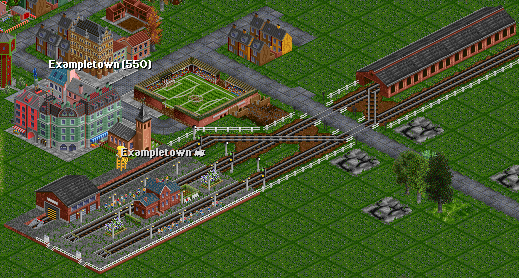
So könnte ein Endbahnhof einer kleinen Nebenbahn bei Verwendung von zusätzlichen Grafiksets aussehen. Es gibt zwei Bahnsteige für Passagiere und ein Gütergleis sowie ein als größerer Lokschuppen getarntes Depot. Bitte nicht von den Signalen verwirren lassen, der Screenshot entstand in TTDPatch, in OpenTTD sehen die Signale etwas anders aus.
